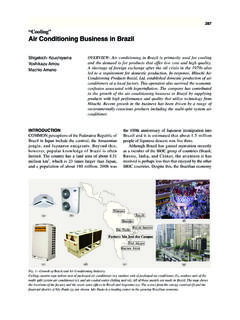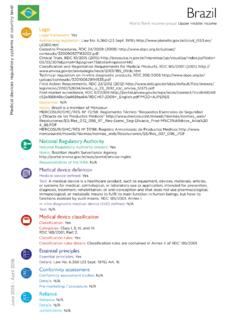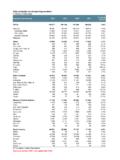Transcription of BRAZIL - OECD.org
1 BRAZIL WATER RESOURCES ALLOCATION OECD 2015 1 BRAZIL Overview and highlights In terms of water resources, BRAZIL is renowned as one of the most water abundant countries. However, adjacent to water abundant Amazon river basin, the Eastern Northeast Atlantic region is chronically afflicted by water shortages. The climate and rainfall patterns are the determining factors for BRAZIL s water resources. Concerns about water shortages, deteriorating water quality, economic development and equity in access to water led to several water reforms since the establishment of the National Water Agency (ANA) in 2000 and the National Water Resources Council (CNRH) in 1998. Reforms included the institutionalisation of water allocation and permits for hydropower plants and fish farming complexes.
2 Water charges were established in several basins and massive regularisation campaigns were conducted. In specific basins, water resources compacts were established, which changed existing rules of water allocation. Key characteristics of the prevailing allocation regime for S o Francisco River Basin include: The major water user is irrigated agriculture, accounting for 68% of total water demand. The current and future sustainability of water use within the basin is considered to be very important for the Brazilian economy; There is significant non-consumptive use, with six hydropower plants contributing to the national integrated energy system; Entitlements can be lost if not used in the given period; At present, the system is neither over-allocated nor over-used. However, there but there are local water conflicts in specific watersheds; Water entitlements are legally defined.
3 However, there are still a large number of users without entitlements. Regularisation campaigned have been conducted; Water permits cannot be traded or leased, but can be transferred; An estimated 92% of all water users in the S o Francisco river basin are considered insignificant and are not required to hold a permit to use water. However this use corresponds to only a small fraction of total water demand. Key characteristics of the prevailing allocation regime for S o Marcos River Basin include: Monthly mean streamflows vary from 40 m3/s in the dry season to 208 m3/s in the rainy season; Irrigated agriculture accounts for 91% of the total water demand; The limit in change in energy production was a key parameter in establishing the cap in water use; Water resources in the basin are currently considered over-used . Rapidly increasing consumptive use for irrigation is generating tensions with hydropower production; Water entitlements are legally defined.
4 However, there are still a large number of users without entitlements. Regularisation campaigned have been conducted; Only hydropower is charged for water use; In the case of droughts the order of priority uses comes into effect. Human and livestock consumption have the first priority. Highly efficient irrigated agriculture has second priority. Hydropower is the third priority use. This country profile was compiled by the OECD Secretariat and reflects information available as of March 2015. Further information and analysis can be found in the publication: OECD (2015) Water Resources Allocation: Sharing Risks and Opportunities, OECD Studies on Water, OECD Publishing. Country profiles for all of the 37 allocation regimes in 27 OECD and key partner countries surveyed for this project are available for download at: BRAZIL 2 WATER RESOURCES ALLOCATION OECD 2015 Legal and institutional setting for water allocation Institution Scale Main Responsibilities National Water Agency (ANA) National Implementation of the national water resources management system and regulation of water sues in federal water bodies.
5 Planning, hydrologic monitoring, regulation (definition of rules and enforcement), issuing water permits in federal water bodies. National Water Resources Council (CNRH) National Definition of general rules, deliberation on water conflicts. State Water Agencies (OGE) State Regulation (definition of rules and enforcement) and issuing water permits in state water bodies. State and Federal District Water Resources Councils (CERHs) State Consulting and deliberative bodies instituted by the States, with the duty of formulating the water resources policy on the respective federative unit level. River Basin Committees (RBC) River basin To debate issues related with water resources management at the water basin level. Definition of water use priorities, approval of river basin plans, articulation among several institutions. River Basin Agencies (RBA) Basin Technical and executive bodies that also act as the Executive Secretariat of the respective Basin Committee.
6 Planning and technical studies to support the RBC. Association of Water Users River basin Representation of water users. Legal context for water allocation: Roman/ Statutory Law Legal definition of ownership of water resources: Ground and surface water is publicly owned. Rivers crossing or serving as state or national boundaries, by Constitution, are considered under federal domain, while groundwater and all other surface water (except reservoirs built by the federal government) are considered under state domain. Tracking water scarcity A mapping exercise has been undertaken to identify areas where water scarcity is becoming a problem. The most recent studies include: State of Water Resources in BRAZIL (2013) Atlas or Urban Water Supply (semi-arid region (2006, 2009), metropolitan regions (2009), southern region (2009), national (2011)) Joint Technical Note no 2/2012/SPR/SRE-ANA(2012) National Water Resources Plan (2005) BRAZIL WATER RESOURCES ALLOCATION OECD 2015 3 Allocation Regime Example: S o Francisco River Basin Physical features of the water resource The Basin covers 636 920 km (8% of BRAZIL ), where more than million people live.
7 It spans 503 municipal zones in six states and the Federal Districts of Minas Gerais, Bahia, Goi s, Distrito Federal, Pernambuco, Alagoas and Sergipe. The current and future sustainability of water use within the basin is very important for the Brazilian economy. The flow rate is partially managed or controlled, as the flow rate can be controlled to some extent. There is significant non-consumptive use in this water system since there are six hydropower plants, which supply a significant portion of the Brazilian electricity demand integrated to the national energy system. The is also a regional waterway system that depends on regularised flows from the Tr s Marias hydropower plant reservoir, located at the upstream portion of the S o Francisco river. Defining the available resource pool Are limits on consumptive use defined?
8 Yes In terms of the volume of water that can be abstracted, linked to a river basin management plan prepared by the river basin agency. The plan is primarily a guiding document, although it can define the priorities for water allocation and that definition is statutory. Are environmental flows clearly defined? Yes Estimated with the Tennant method in most parts of the river (10% of long term average flow) and by an old environmental requirement of 1 300 m3/s at the mouth of the S o Francisco river. Flow requirements for freshwater and territorial biodiversity are not considered. Are there arrangements to deal with impacts of climate change? Under development The water resources plan will be reviewed soon by the river basin agency and it might consider potential impacts of climate change on water availability. ANA and Funceme established technical co-operation called Adaptation of planning and water resources operation to climate change and variability in the S o Francisco river basin.
9 The study provides evaluations of the impacts of climate change in the basin. Annual rainfall consumed per use: Agriculture ( )Domestic ( )Industrial ( )Environment (evapo-transpiration)Transfer to the sea oranother system ( )Livestock ( )Rural population ( )Remaining flow in theriver6% Annual natural (unimpaired) flow consumed per use: AgricultureDomestic ( )Industrial ( )Transfer to the sea or anothersystem ( )Livestock ( )Rural population ( )Remaining flow in the riverBRAZIL 4 WATER RESOURCES ALLOCATION OECD 2015 What is the status of resource pool? Neither over-used nor over-allocated. Overall, the water system is neither over-allocated nor over-used, but there are local water conflicts in specific watersheds where the local water systems are over-used.
10 Moreover, although water availability is sufficient to meet all water demand projected until 2025 (and probably well beyond), there are a number of legally approved entitlements which are not currently used. Those entitlements refer to large irrigation districts which are at various stages of development. The approved entitlements for 23 large irrigation districts were revised in 2010 in order to match the current water use with water permit conditions. Local water conflicts in federal water bodies have been managed through water resources compacts and negotiated water allocation processes. Factors taken into account in the definition of the available resource pool Factor Taken into account? If taken into account, how? Non-consumptive uses ( navigation, hydroelectricity) Flow requirement for navigation were considered where commercial navigation occurs.

















